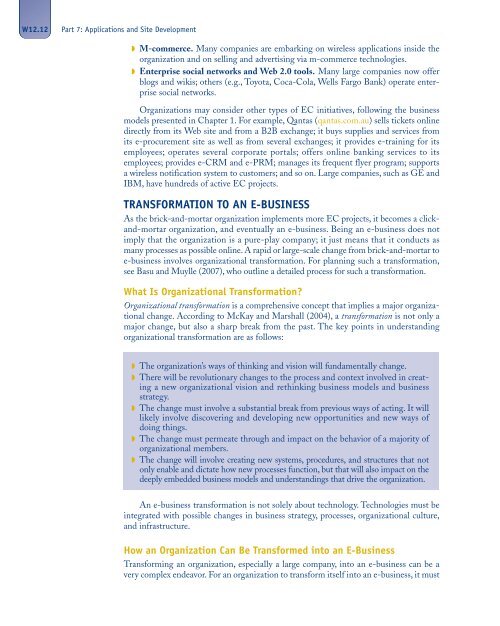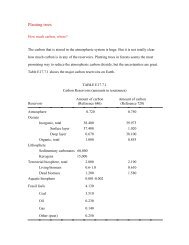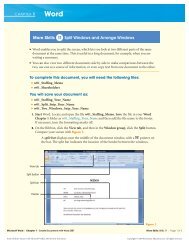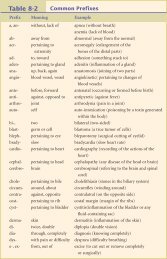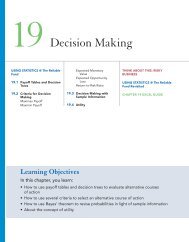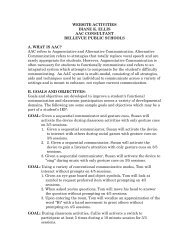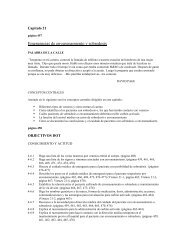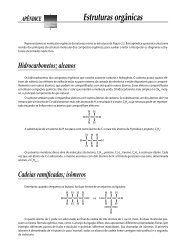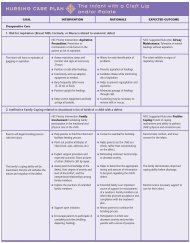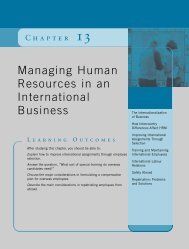launching a successful online business and ec projects - Prentice Hall
launching a successful online business and ec projects - Prentice Hall
launching a successful online business and ec projects - Prentice Hall
You also want an ePaper? Increase the reach of your titles
YUMPU automatically turns print PDFs into web optimized ePapers that Google loves.
W12.12 Part 7: Applications <strong>and</strong> Site Development<br />
◗ M-commerce. Many companies are embarking on wireless applications inside the<br />
organization <strong>and</strong> on selling <strong>and</strong> advertising via m-commerce t<strong>ec</strong>hnologies.<br />
◗ Enterprise social networks <strong>and</strong> Web 2.0 tools. Many large companies now offer<br />
blogs <strong>and</strong> wikis; others (e.g., Toyota, Coca-Cola, Wells Fargo Bank) operate enterprise<br />
social networks.<br />
Organizations may consider other types of EC initiatives, following the <strong>business</strong><br />
models presented in Chapter 1. For example, Qantas (qantas.com.au) sells tickets <strong>online</strong><br />
dir<strong>ec</strong>tly from its Web site <strong>and</strong> from a B2B exchange; it buys supplies <strong>and</strong> services from<br />
its e-procurement site as well as from several exchanges; it provides e-training for its<br />
employees; operates several corporate portals; offers <strong>online</strong> banking services to its<br />
employees; provides e-CRM <strong>and</strong> e-PRM; manages its frequent flyer program; supports<br />
a wireless notification system to customers; <strong>and</strong> so on. Large companies, such as GE <strong>and</strong><br />
IBM, have hundreds of active EC proj<strong>ec</strong>ts.<br />
TRANSFORMATION TO AN E-BUSINESS<br />
As the brick-<strong>and</strong>-mortar organization implements more EC proj<strong>ec</strong>ts, it b<strong>ec</strong>omes a click<strong>and</strong>-mortar<br />
organization, <strong>and</strong> eventually an e-<strong>business</strong>. Being an e-<strong>business</strong> does not<br />
imply that the organization is a pure-play company; it just means that it conducts as<br />
many processes as possible <strong>online</strong>. A rapid or large-scale change from brick-<strong>and</strong>-mortar to<br />
e-<strong>business</strong> involves organizational transformation. For planning such a transformation,<br />
see Basu <strong>and</strong> Muylle (2007), who outline a detailed process for such a transformation.<br />
What Is Organizational Transformation?<br />
Organizational transformation is a comprehensive concept that implies a major organizational<br />
change. According to McKay <strong>and</strong> Marshall (2004), a transformation is not only a<br />
major change, but also a sharp break from the past. The key points in underst<strong>and</strong>ing<br />
organizational transformation are as follows:<br />
◗ The organization’s ways of thinking <strong>and</strong> vision will fundamentally change.<br />
◗ There will be revolutionary changes to the process <strong>and</strong> context involved in creating<br />
a new organizational vision <strong>and</strong> rethinking <strong>business</strong> models <strong>and</strong> <strong>business</strong><br />
strategy.<br />
◗ The change must involve a substantial break from previous ways of acting. It will<br />
likely involve discovering <strong>and</strong> developing new opportunities <strong>and</strong> new ways of<br />
doing things.<br />
◗ The change must permeate through <strong>and</strong> impact on the behavior of a majority of<br />
organizational members.<br />
◗ The change will involve creating new systems, procedures, <strong>and</strong> structures that not<br />
only enable <strong>and</strong> dictate how new processes function, but that will also impact on the<br />
deeply embedded <strong>business</strong> models <strong>and</strong> underst<strong>and</strong>ings that drive the organization.<br />
An e-<strong>business</strong> transformation is not solely about t<strong>ec</strong>hnology. T<strong>ec</strong>hnologies must be<br />
integrated with possible changes in <strong>business</strong> strategy, processes, organizational culture,<br />
<strong>and</strong> infrastructure.<br />
How an Organization Can Be Transformed into an E-Business<br />
Transforming an organization, esp<strong>ec</strong>ially a large company, into an e-<strong>business</strong> can be a<br />
very complex endeavor. For an organization to transform itself into an e-<strong>business</strong>, it must


